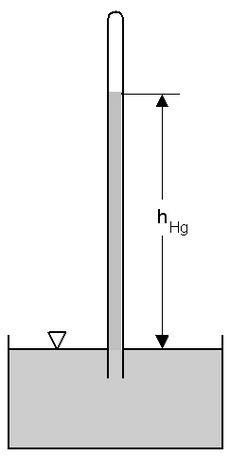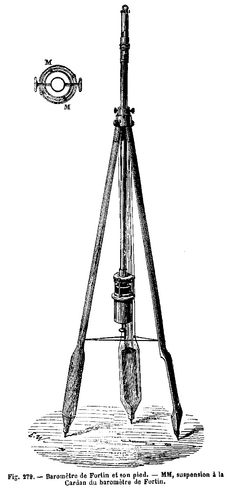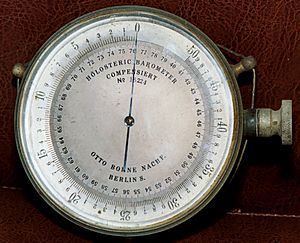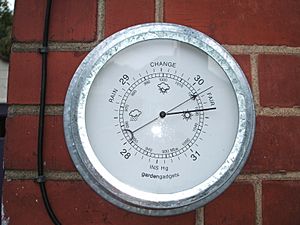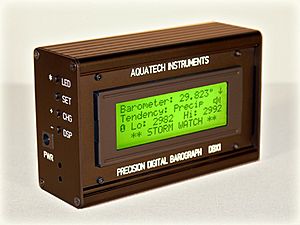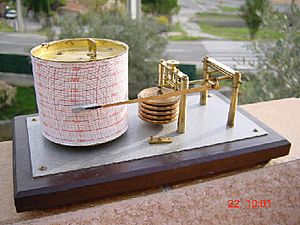Barometer facts for kids
A barometer is a cool tool that measures air pressure. Think of air pressure as the weight of the air pushing down on everything around us. Barometers help us understand how heavy or light the air is, using units like hectopascals (hPa).
There are different kinds of barometers, like the water barometer, aneroid barometer, and the mercury barometer. The very first barometer, the mercury barometer, was invented by an Italian mathematician named Evangelista Torricelli in 1643.
Barometers are used for many things! They can measure altitude, which is how high something is above the ground, like a mountain or a hot air balloon. They are also super important in modern aviation, helping planes fly safely. Miners sometimes use them to figure out how deep a mine is. But the most common use for barometers is to help meteorologists (weather scientists) predict the weather.
Contents
History of Barometers
Even though Evangelista Torricelli is famous for inventing the barometer in 1643, some records suggest another Italian, Gasparo Berti, might have accidentally built a water barometer a few years earlier, between 1640 and 1643. Also, the French scientist René Descartes described how to design an experiment to measure air pressure way back in 1631. However, there's no proof he actually built one at that time.
Types of Barometers
Water-Based Barometers
Have you ever heard that falling air pressure means stormy weather is coming? This idea is behind a simple weather tool called a "weather glass" or "Goethe barometer." It's named after Johann Wolfgang von Goethe, a famous German writer who made a simple version based on Torricelli's ideas.
This type of barometer is a glass container, usually half-filled with water. It has a narrow spout that goes into the water and then rises above it, open to the air.
- When air pressure drops, the water level in the spout rises higher than the water in the main container. This means bad weather might be on the way.
- When air pressure increases, the water level in the spout drops lower. This usually means good weather is coming!
You can even make a simple version of this at home!
Mercury Barometers
A mercury barometer uses a glass tube that's closed at one end and filled with mercury. The open end sits in a pool of mercury. The weight of the mercury in the tube creates an empty space at the top, called a vacuum.
- When air pressure is high, it pushes down harder on the mercury pool, forcing the mercury higher up the tube.
- When air pressure is low, it pushes less, and the mercury level in the tube drops.
Torricelli noticed that the mercury height changed a little each day. He realized this was because the pressure of the air around us was changing. He famously said, "We live submerged at the bottom of an ocean of elementary air, which is known by incontestable experiments to have weight."
Over time, mercury barometers were improved to be more accurate and easier to use. Some even combine a barometer with a thermometer, like the Fitzroy barometer. However, since 2007, it's harder to buy new mercury barometers in Europe due to rules about mercury.
Vacuum Pump Oil Barometers
Did you know there's a "World's Tallest Barometer"? It was built in 2013 at Portland State University. This giant barometer uses special vacuum pump oil instead of mercury. Because this oil is much lighter than mercury, the column of oil needs to be super tall – about 12.4 meters (over 40 feet) high!
Aneroid Barometers
An aneroid barometer measures pressure without using any liquid. It was invented in 1844 by a French scientist named Lucien Vidi.
- It uses a small, flexible metal box called an aneroid cell. This cell is made from a special metal mix and has most of the air removed from inside it.
- When the outside air pressure changes, the cell either expands (gets bigger) or contracts (gets smaller).
- These tiny movements are connected to a system of levers and springs. These levers make the small movements much bigger, so you can see them on a dial with a pointer.
Many aneroid barometers have a second needle you can set to mark the current pressure. This way, you can easily see if the pressure has gone up or down. Tapping the barometer can also show if the pressure is rising or falling as the pointer moves. These barometers are common in homes, on boats, and in small airplanes. They are also used by weather scientists.
Barographs
A barograph is a special type of barometer that doesn't just show the pressure; it actually draws a graph of how the air pressure changes over time. This helps scientists see trends!
MEMS Barometers

MEMS barometers are super tiny devices, usually smaller than a grain of sand! They are made using very advanced technology. You can find these tiny barometers in modern gadgets like smartphones (such as the Samsung Galaxy and Apple iPhone 6) and smartwatches. They can help with things like figuring out your elevation or even giving short-term weather forecasts.
How Barometers Are Used
Barometers are incredibly useful for predicting the weather. Since the late 1800s, people have used air pressure and how it changes to make forecasts.
- When air pressure drops quickly, it often means a stormy weather system is coming, bringing clouds and rain.
- When air pressure rises quickly, it usually means clear skies and improving weather are on the way.
Weather scientists use barometer readings from many places to create weather maps. These maps show areas of high and low pressure, helping them predict where storms will go.
Barometers also have other important uses:
- In deep mines, falling air pressure can cause dangerous gases to escape from the coal. Miners use barometers to keep track of the pressure and stay safe.
- Scuba divers use special pressure gauges, which are like barometers, to check how much air is left in their tanks and how deep they are underwater.
Adjusting Barometer Readings
Temperature Adjustments
The density of mercury changes with temperature. So, for mercury barometers, a thermometer is often attached to help adjust the reading for the correct temperature. Aneroid barometers also have a way to adjust for temperature changes, though simpler home models might not.
Altitude Adjustments
Air pressure changes with altitude. It's lower on top of a mountain and higher at sea level.
- If you take a barometer from sea level to a mountain, its reading will drop, even if the weather isn't changing.
- To make sure readings are fair, they are often adjusted to what they would be at sea level. This helps avoid false alarms about storms at higher elevations.
Many aneroid barometers let you set them to show the sea-level pressure directly. You can do this by checking the local weather station's pressure reading (which is already adjusted to sea level) and then turning the dial on your barometer to match it.
How to Create a Homemade Barometer
This is a fun project to understand how barometers work!
You will need:
- Glass bottle or a small coffee can
- Balloon
- Wooden skewer or straw
- Rubber band
- Tape (or super glue)
- Ruler or printable weather chart
- Scissors
1. Prepare the Balloon: Cut the neck off the balloon. Stretch the remaining part very tightly over the mouth of the bottle or can. Make sure it's smooth with no wrinkles. Secure it tightly with a rubber band around the bottle's neck.
2. Attach the Skewer/Straw: Tape or glue one end of the wooden skewer or straw to the very center of the balloon. Make sure the other end of the skewer or straw sticks out past the edge of the bottle. This will be your pointer.
3. Create a Measurement Scale: Place your homemade barometer on a flat surface. Keep it away from windows or heaters, as temperature changes can affect it. Put a ruler or your printed weather chart next to the pointer. Mark where the pointer is when you first set it up. This is your starting point.
4. Record Initial Reading: Write down the date and where the pointer is on your scale. This is your baseline measurement.
How to Use Your Homemade Barometer
Your barometer measures air pressure, which changes with the weather.
- When outside air pressure increases, it pushes down on the balloon. This makes your skewer or straw pointer rise. A rising pointer often means good, clear weather is coming!
- When outside air pressure decreases, the balloon bulges slightly outward. This makes the skewer or straw pointer drop. A falling pointer can mean rain or storms might be on the way.
1. Check your barometer every day at the same time. Record the pointer's position and the date. 2. Watch how the pointer moves: * If the pointer rises, air pressure is increasing. Expect clear and sunny weather. * If the pointer falls, air pressure is decreasing. Expect cloudy or rainy weather. 3. Over time, you'll start to see patterns! This will help you predict short-term weather changes.
Images for kids
See also
 In Spanish: Barómetro para niños
In Spanish: Barómetro para niños



